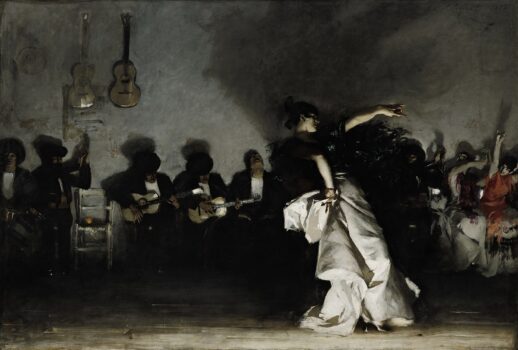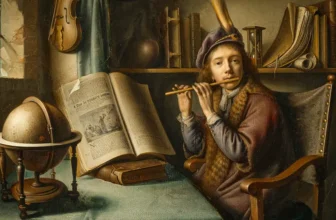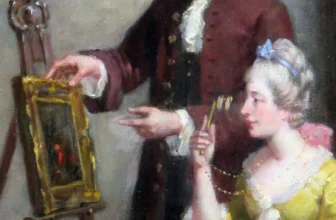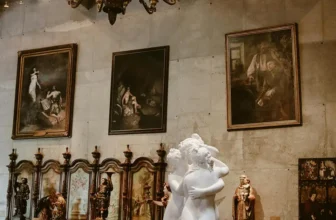Exploring El Jaleo Painting by John Singer Sargent
Shopping Ads: Antique Oil Paintings On Canvas For Sale. Limited Originals Available 💰😊
Authentic hidden masterpieces, Explore old master antique oil paintings from the Renaissance and Baroque eras. From 15th-century to 18th-century Antique Paintings. Bring the Renaissance and Baroque in your home. Shop Now!
🎨 Antique Oil Paintings On Canvas Renaissance, Baroque Art Antique Oil Paintings, Make Offer 16th to 18th Century Portrait Paintings
In the dim glow of a spotlight, a flamenco dancer is captured mid-motion, the rhythmic stomp of her heel echoing in the smoky silence of an imagined Andalusian night. Her arms twist above her head in a gesture that is both wild and precise. Around her, shadowy guitarists watch, transfixed in silent support. This moment, timeless, fierce, and utterly captivating, is immortalized in El Jaleo, one of the most striking and enigmatic works by the American master painter John Singer Sargent.
Who Painted El Jaleo?
El Jaleo was painted in 1882 by John Singer Sargent, a celebrated American expatriate artist known for his evocative portraits and technical brilliance. Born in Florence in 1856 to American parents, Sargent was steeped in European culture from a young age. He trained at the École des Beaux-Arts in Paris and was heavily influenced by the Old Masters, particularly Velázquez and Frans Hals, as well as the Impressionists.
Although Sargent is best remembered for his lush, psychologically nuanced portraits of Edwardian high society, El Jaleo marks a different chapter in his artistic journey. It reflects a brief but intense period of fascination with Spanish culture, especially flamenco music and dance, which he experienced firsthand during his travels through Spain in 1879–1880.
What Type of Art Is El Jaleo?
El Jaleo is a large-scale oil painting, nearly 8 feet tall and 11 feet wide, that straddles the line between realism, romanticism, and theatrical impressionism. It is not a portrait, though it depicts a figure in a specific moment. It is not a genre painting in the traditional sense, though it illustrates a recognizable cultural scene. Rather, El Jaleo is best understood as a dramatic evocation of movement, atmosphere, and performance, painted with a boldness and vigor that defied artistic norms of the time.
In stylistic terms, the work is often categorized as Orientalist due to its exoticized depiction of Spanish culture, especially flamenco, which was seen by many 19th-century Europeans and Americans as both alluring and dangerous. But it also draws heavily on realist techniques, note the carefully rendered fabrics and the studied chiaroscuro, and contains impressionistic flourishes in the dancer’s blurred motion and the light’s interplay on the wall behind her.
What Is the Meaning of El Jaleo?
The title El Jaleo is a Spanish term that loosely translates to “the ruckus” or “uproar.” In the context of flamenco, it refers to the enthusiastic clapping, shouts, and foot-stomping that accompany a performance, a participatory explosion of rhythm and emotion. In essence, El Jaleo encapsulates the soul of flamenco: not just a dance, but a communal act of expression that channels centuries of joy, pain, and survival.
Sargent’s painting is not simply a depiction of a dancer on stage. It’s a tribute to the raw intensity of Spanish gypsy (Romani) culture and flamenco’s primal energy. The lone dancer dominates the foreground, a spectral figure clad in white whose dramatic pose suggests ecstasy, trance, or even spiritual possession. Her form is contrasted starkly against the dark semicircle of musicians, whose guitars and faces are half-lost in shadow.
But the true genius of the painting lies in its use of light and space. A low, almost subterranean light source casts enormous shadows of the dancer’s skirt and hands onto the rough plaster wall behind her, creating a ghostly echo of her form. This duality, real and reflected, presence and performance, infuses the painting with an uncanny depth and rhythm. The shadows seem to dance too, like memories or ancestors summoned by the music.
The Creation of El Jaleo: A Cultural Pilgrimage
Sargent’s Spanish sojourn in 1879–80 proved to be one of the most transformative periods of his life. Fueled by his admiration for Diego Velázquez and the emerging field of ethnographic art, Sargent journeyed through Andalusia, Madrid, and Seville. He filled sketchbooks with studies of architecture, costume, dancers, and musicians. He attended flamenco performances in taverns and courtyards, often sketching by candlelight.
The experience inspired a series of Spanish-themed works, but none would be as ambitious or as haunting as El Jaleo. He completed the painting in Paris in 1882, working from his notes and sketches. The model for the dancer is believed to be a professional flamenco performer, possibly of Romani descent. Sargent set the scene in a fictional, imagined performance space, a distillation of the various locales he had visited in Spain.
Reception and Controversy
When El Jaleo was exhibited at the Salon of 1882 in Paris, it received a mixed but passionate response. Critics were divided. Some praised its audacity, drama, and technical mastery. Others found it too flamboyant, even vulgar. The painting’s bold composition, dramatic lighting, and its depiction of a dancer in a moment of intense, almost erotic passion, unsettled many Victorian viewers.
Nevertheless, the painting found a powerful admirer in Isabella Stewart Gardner, the famed Boston art collector and philanthropist. She purchased the painting in 1914 and installed it in her Venetian-style palace, the Isabella Stewart Gardner Museum, where it remains today.
Where Is El Jaleo Painting Now?
Today, El Jaleo is housed in the Isabella Stewart Gardner Museum in Boston, Massachusetts. It occupies a special place in the museum: a shadowy alcove near the entrance known as the Spanish Cloister, flanked by Spanish tiles, wrought iron lanterns, and a Moorish fountain. Gardner had the room designed specifically to complement the painting, transforming the space into a kind of shrine to Andalusian mystique.
Seeing El Jaleo in person is a profound experience. The painting’s size and dynamism seem to pulsate within the semi-darkness of the cloister, inviting viewers to step into its world. The crackle of guitar strings, the snap of fingers, and the haunting voice of cante jondo seem to hang invisibly in the air. The dancer, frozen in eternal motion, performs forever in her private ritual of defiance and beauty.
Symbolism and Themes in El Jaleo
While El Jaleo is anchored in realism, it is also rich in symbolic and psychological undertones:
Femininity and Power: The central figure is both sensual and commanding. She is not an object for the male gaze but a vessel of expression, defying conventional representations of women in 19th-century art.
Cultural Otherness: Sargent’s portrayal of Spanish Romani culture reflects the era’s fascination with “the exotic,” but it is also infused with empathy and admiration. Unlike many Orientalist works that patronize or caricature their subjects, El Jaleo conveys genuine respect.
Shadow and Performance: The shadows on the wall are not just technical feats, they are metaphors for memory, identity, and the duplicity of performance. The dancer exists both as flesh and as echo, real and imagined.
Transcendence through Art: In capturing a fleeting gesture and elevating it to monumental scale, Sargent suggests that art, like dance, can be a form of transcendence, lifting both artist and audience out of the ordinary.
Sargent and Spanish Influence
El Jaleo was a turning point in Sargent’s career. It showcased his ability to synthesize travel experience, cultural immersion, and painterly bravado into a single vision. Though he would soon move into portraiture, eventually becoming the most sought-after society portraitist of his time, his Spanish works, particularly El Jaleo, remained among his personal favorites.
Sargent’s admiration for Velázquez and Spanish aesthetics can be seen in many of his later works. Even in his formal portraits, one can detect echoes of El Jaleo in the theatrical poses, deep shadows, and psychological presence of his subjects.
In the 21st century, El Jaleo continues to fascinate art historians, flamenco scholars, and general viewers alike. It is regularly cited as one of Sargent’s masterpieces, even though it departs so radically from the works that made him famous.
The painting’s modern resonance lies in its refusal to be neatly categorized. It is a portrait without a name, a narrative without a plot, a scene without a stage. And yet, it tells a story more powerfully than most novels or biographies ever could, a story of cultural fusion, artistic daring, and the eternal human need to express.
A Dance Eternal
El Jaleo is not merely a painting. It is a performance captured in pigment and shadow, a moment that lives beyond time. Through the veil of candlelight and castanets, John Singer Sargent invites us to witness a sacred act, not just of flamenco, but of transformation. The dancer, anonymous and incandescent, is not just a woman in motion. She is Spain. She is passion. She is art itself.
And so she dances, forever.




